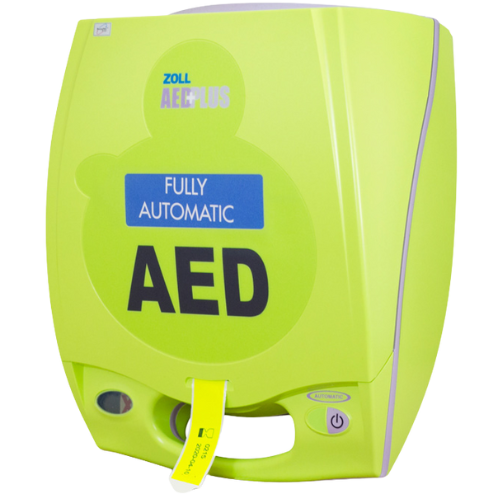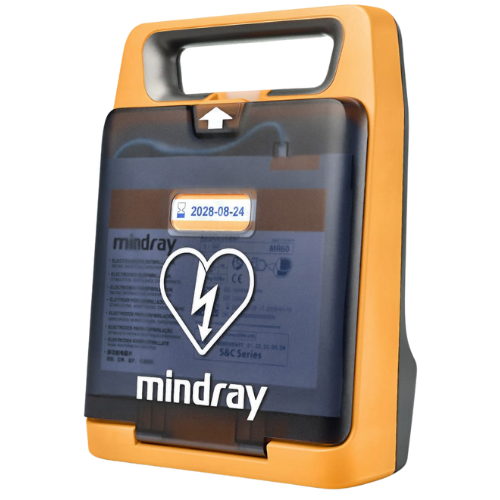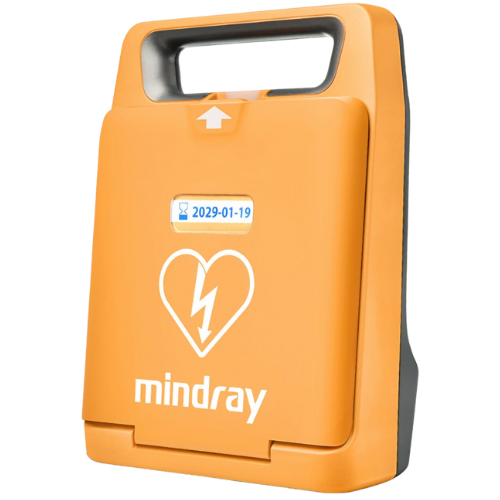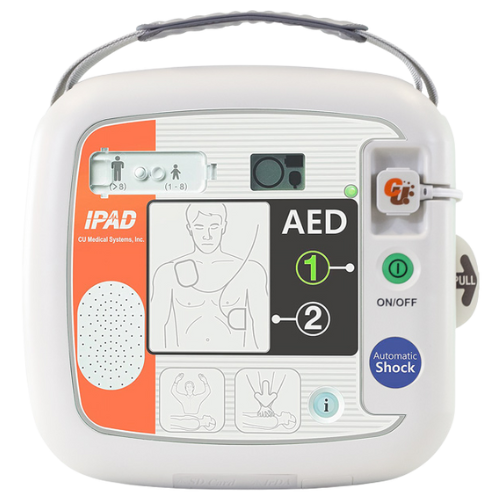Keeping Your AED Separate Could Cost You
Separating your AED from first-aid supplies can result in unnecessary delays during a critical moment, impacting survival chances dramatically.
In a real workplace emergency, clarity and speed are everything. Sudden cardiac arrest does not wait for staff to search cupboards or debate which equipment to bring. The clock starts the instant someone collapses, and every minute without defibrillation slashes the chance of survival by 10%.
When lifesaving tools like Automated External Defibrillators (AEDs) and first-aid supplies are kept apart, responders waste valuable seconds choosing what to grab, searching different locations, or even realising too late that an AED was available. For a casualty, those moments can be the difference between a quick recovery and a fatal outcome.
Many UK workplaces meet the minimum requirement by having a basic first-aid kit. Fewer really consider how this kit should work when lives are on the line. The Health and Safety (First-Aid) Regulations 1981 require employers to provide adequate first-aid equipment, facilities, and personnel, but “adequate” is not the same as “optimal”. AEDs are now widely recognised as a critical part of workplace emergency response. Even in high-risk environments, they are often stored separately from the first line of medical kit or placed in locations that aren’t clearly signposted.
In practice, even well-meaning colleagues face unnecessary barriers at the most crucial moment. If your kit is hard to find, or your responder has to run back for missing pads or wires, you lose time and increase risk. Integrating an AED into your core first-aid setup is a practical step that creates a single, proven response. This supports your legal duties and gives every team member the practical confidence that comes from knowing exactly where to turn.
Common Pitfalls
The number one mistake is treating AEDs and first-aid supplies as two separate problems. Many employers invest in a defibrillator but leave it locked away, wall-mounted out of sight, or tucked into a corner no one uses. At the same time, they continue to treat the first-aid box as the “go-to” for real-world emergencies, assuming someone will somehow remember the AED despite different storage, signposting, and checks.
Other classic oversights include:
Picking an AED model that won’t physically fit with other first-aid supplies, or that isn’t designed to be portable
Failing to train all first-aiders (and staff generally) in how to use the AED as part of an incident response
Neglecting to include key items, like spare pads or scissors, needed to use the AED on real casualties
Not labelling or signposting the combined kit clearly enough for new staff, contractors, or visitors to find it fast
Forgetting to schedule joint (AED and first aid) maintenance and checks, so the kit is always operational
These errors create bottlenecks in a system that should feel seamless. In a workplace incident, the last thing you want is a responder standing over a casualty, only to realise the right kit is on another floor or a wall bracket is empty because the AED battery expired months ago.
Step-by-Step Fix
The best way to fix this problem is methodical, practical, and proven. UK workplaces can upgrade their emergency kit for speed, compliance and confidence by following these steps.
Step 1. Choose the right AED for workplace integration
Not every AED makes sense for a quick-grab kit. Pick a compact, lightweight, easy-to-operate model intended for non-clinical settings. The iPAD SP1 Fully-Automatic Defibrillator is a good example. It is tough, simple to use, and fits well with other key first-aid resources.
When assessing models, check:
The AED comes with a tough carry case (preferably with space for scissors, a razor, spare pads, and a face shield)
It’s MHRA and HSE recommended (or better)
The front panel has clear graphics and instructions even under pressure
The model supports both adult and child use, either with a switch or separate pads
DefibSpace Tip:
Always consider who will use the AED in a panic. Test the unboxing and see if your go-to first-aider can deploy it unaided in under two minutes.
Step 2. Combine your AED and basic first-aid kit in one visible container
Gather all your critical emergency items – AED, pads (including spare sets), battery, trauma scissors, razor, face shield or pocket mask, gloves, and basic wound dressings – into a single, clearly marked bag or grab box. Use a sturdy, easily opened container with obvious “First Aid + Defibrillator” signage on multiple sides.
Store this in a prominent location, known to everyone on site. Place signage at entranceways and on evacuation routes pointing to this kit.
DefibSpace Tip:
If you have multiple floors or large premises, standardise the kit in every area. Never put key equipment in a locked cupboard or room unless your setup and local risks require controlled access.
Step 3. Train responders in both first aid and AED use together
It is not enough to rely on workplace “AED familiarity”. Arrange for all nominated first-aiders, and ideally all staff, to have practical AED and CPR training. Always include a real-world scenario where they have to fetch and use the combined kit under time pressure. Use regular workplace drills so staff instinctively go for the integrated kit rather than splitting steps between first aid checks and separate AED retrieval.
Record training dates and keep them up to date on your HSE documentation.
DefibSpace Tip:
Get your AED supplier or a local training provider to run a “live” session using your actual equipment in the real environment you expect to use it. This often uncovers hidden site-specific obstacles.
Step 4. Schedule and log joint maintenance checks
Maintenance is often the weakest link. Missed checks are regularly cited in incident investigations. Keep a clear log of every inspection, following both the AED manufacturer’s and your first-aid kit supplier’s checklists. Include battery condition, pad expiry, visual checks for damage, and a quick test of the full kit’s accessibility (for example, can the bag be lifted and opened in five seconds?).
Check the integrated kit monthly, noting down responsible persons and dates, and share this log with your HSE lead or safety committee.
DefibSpace Tip:
Stick an inspection checklist directly to the inside lid of your integrated kit bag or box. This gives every staff member a visual cue to check everything at a glance.
Step 5. Make your system obvious and easy for everyone on site
Label the integrated kit, display clear HSE-standard pictogram signage, and put waymarking from main doors and communal spaces. Update induction checklists and building maps to feature the kit. If your workforce includes temporary staff, contractors, or the public, ensure the kit can be opened and used by anyone, not just designated managers.
If the kit moves (such as in a vehicle or during shift changes), keep a check-out log so its location is always clear.
DefibSpace Tip:
Walk a new starter or visitor through your premises and ask them about the kit’s location. If they hesitate, you need to improve your signs or instructions.
Step 6. Review and rehearse regularly
Emergency needs change. Review your setup at least annually or after any serious incident or near miss. Update kit contents, relocate equipment if needed, and refresh staff training. Add lessons learned from real incidents, such as access issues or unexpected delays, into the update cycle.
DefibSpace Tip:
After every planned drill or real incident, run a quick debrief. Capture what worked, what slowed you down, and update your kit and signage immediately.
What Most People Miss
The real challenge is not simply owning the right kit, but having a clear, automatic process that removes decision-making when it counts. Many well-intentioned teams rehearse procedures “on paper”, but never actually try a scenario where a member must grab the combined kit, run to a casualty, unlock the bag, attach the pads, and call for help without delay.
People often overlook the sheer pressure and confusion that comes during a live emergency. In those moments, basics like clear labelling, obvious signage, and a single, easy-to-grab kit are what enable a swift, life-saving response. Being ready for real emergencies—not just audits—sets a truly prepared workplace apart.
Jargon Buster
AED (Automated External Defibrillator): Portable device that delivers an electric shock to restart a stopped heart after sudden cardiac arrest.
CPR (Cardiopulmonary Resuscitation): Emergency technique using chest compressions and breaths to keep blood and oxygen moving in the body.
HSE (Health and Safety Executive): The UK's national regulator for workplace health and safety.
First-Aid Kit: Set of supplies for treating injuries and illnesses until professional help arrives.
Regulatory Compliance: Meeting minimum legal requirements and safety best practices at your workplace.
The Bigger Picture
Integrating an AED directly into your first-aid setup simplifies your emergency response plan for everyone, on every shift, and in any incident. Your organisation moves beyond just meeting requirements—you are ahead of regulation and ahead of risk. A kit like this makes HSE compliance straightforward and shows genuine commitment to workplace safety for staff, visitors, and contractors.
Integrated kits also mean:
Shorter response times in true emergencies, leading to greatly improved survival odds
Reduced chance of errors under pressure, as there’s no confusion about what to grab or where to find it
Easier training and induction—just one process, one kit, one location
Clear paper trail of maintenance and checks for incident review or HSE inspection
Lower risk of reputational damage or legal exposure—if the worst happens, you can show practical steps above and beyond the minimum duty
Above all, you build real-world resilience and confidence. Any member of your team knows they can help immediately, with zero hesitation.
Wrap-Up
Putting your AED in with your first-aid kit creates a single, fast, reliable emergency kit that anyone can use under pressure. These steps help you make the right equipment choices, combine critical supplies, set up clear systems, and stay current with training and checks, while supporting both HSE best practice and your own peace of mind.
Do not let a life-saving device go unnoticed or unused because of a split-second delay or unclear process. Bring your AED and first-aid resources together. Make it obvious. Make it fool-proof. Make every second count in the moments when it truly matters.
Quick FAQs
How often should we check our AED and integrated kit?
At minimum, do a joint monthly check. This should include the AED battery and pads, any expiry dates, basic kit items, and overall readiness.
Do all staff need to be trained to use the AED?
While not all staff must be trained by law, best practice is to train all first-aiders and as many staff as practical, as emergencies can happen to anyone, anywhere.
Is there a legal requirement to combine AEDs and first-aid kits?
UK law (as of 2024) does not mandate this integration, but HSE strongly recommends clear, accessible emergency equipment and staff who know how to use it. Combined kits support both recommendations and best-practice guidance.
Which AED models work best in a first-aid kit?
Choose a compact, intuitive device like the iPAD SP1 Fully-Automatic Defibrillator, made for fast, stress-free use anywhere onsite.
What else should be in our integrated kit besides the AED?
Include spare pads, trauma scissors, a razor, gloves, pocket mask, wipes, and core first-aid dressings. Make sure everything is easy to reach in under a minute.
Need to upgrade your emergency setup?
Find the iPAD SP1 Fully-Automatic Defibrillator here and contact DefibSpace for support in building the right integrated solution for your team.







